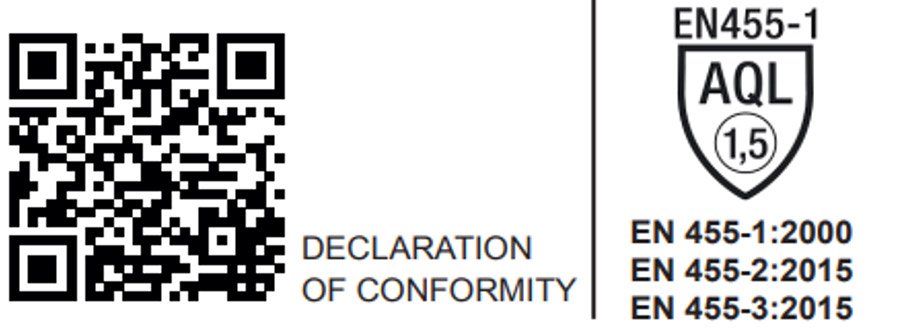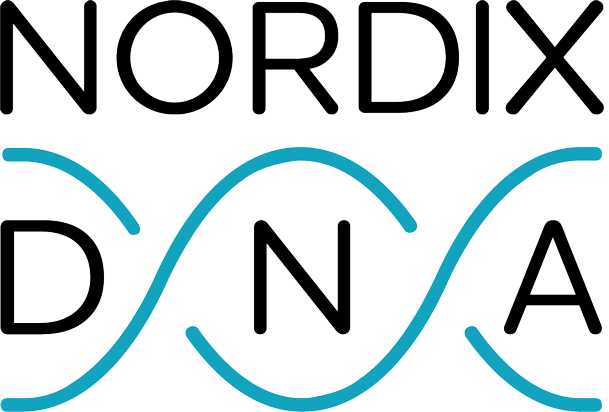1. Instructions for use for a protective glove
GLOVE: NORDIX DNA NITRILE GLOVE
This product has been manufactured following the requirements of Regulation (EU) 2016/425, for its basic use, according to the standard EN 420:2003+A1:2009 / EN ISO 21420:2020 (Protective gloves — General requirements), EN ISO 374-1:2016/A1:2018 (Protective gloves against dangerous chemicals and micro-organisms – Part 1: Terminology and performance requirements for chemical risks) and EN ISO 374-5:2016 (Protective gloves against dangerous chemicals and micro-organisms – Part 5: Terminology and performance requirements for micro-organisms risks), as stated in the certificate No. UE-000044/00 issued by Eurofins Textile Testing, C/ Germán Bernácer nº 4, 03203 Elche-Alicante, Spain, Notified Body No. 2865.
This PPE is made of the following materials: Powder-free blue Nitrile.
IT IS RECOMMENDED THE USER READ THIS MANUAL CAREFULLY AND TO FOLLOW THE GENERAL INSTRUCTIONS.

THE MANUFACTURER DISCLAIMS ALL RESPONSIBILITY FOR DAMAGES OR DETERIORATIONS CAUSED BY UNAUTHORIZED MODIFICATIONS MADE TO THE PPE BY THE USER.


2. Warnings and limitations of use
- Dirt or substance residues adhering to the glove can impair its performance.
- Protective equipment does not act as a chemical barrier at the molecular level.
- The glove has to be removed carefully to avoid any product residue left on the surface of the PPE from coming into contact with the skin.
- Carry out an inspection before putting on the PPE to ensure that it is in perfect condition.
- This product does not offer protection against gases and vapors.
- The user must know the use and handling of the glove.
- This product must not be used against risks other than those described above.
- ”Before usage, inspect the gloves for any defect or imperfections.”
- ”This information does not reflect the actual duration of protection in the workplace and the differentiation between mixtures and pure chemicals.”
- EN 374-4:2013 Degradation levels indicate the change in puncture resistance of the gloves after exposure to the challenge chemical.
- ”The chemical resistance has been assessed under laboratory conditions from samples taken from the palm only and relates only to the chemical tested. It can be different if the chemical is used in a mixture.”
- ”It is recommended to check that the gloves are suitable for the intended use because the conditions at the workplace may differ from the type test depending on temperature, abrasion and degradation.”
- ”When used, protective gloves may provide less resistance to the dangerous chemical due to changes in physical properties. Movements, snagging, rubbing, degradation caused by the chemical contact etc. may reduce the actual use time significantly. For corrosive chemicals, degradation can be the most important factor to consider in selection of chemical resistant gloves·”
- ”Before usage, inspect the gloves for any defect or imperfections.”
3. Properties: The higher the class, the greater the protection
| Penetration | ||
|---|---|---|
| EN 374-2:2014 | Air leak | Pass |
| Water leak | ||
| Permeation performance level | |
|---|---|
| Measured breakthrough time | Permeation performance level |
| > 10min. | Level 1 |
| > 30 min. | Level 2 |
| > 60 min. | Level 3 |
| > 120 min. | Level 4 |
| > 240 min. | Level 5 |
| > 480 min. | Level 6 |
| PROTECTION AGAINST VIRUS EN ISO 374-5:2016 | |
|---|---|
| ISO 16604, Procedure B | Pass |
| CHEMICALS EN ISO 374-1:2016/A1:2018 | ||
|---|---|---|
| CODE | CHEMICAL | CAS NUMBER |
| K | Sodium hydroxide 40% | 1310-73-2 |
| P | Hydrogen peroxide (30%) | 7722-84-1 |
| T | Formaldehyde (37%) | 50-00-0 |
| EN 16523:2015 PermeationType B K P T |
CHEMICAL | LEVEL |
| Sodium hydroxide 40% | 6 | |
| Hydrogen peroxide (30%) | 5 | |
| Formaldehyde (37%) | 4 | |
| EN ISO 374-4:2013
Degradation |
CHEMICAL | Mean Degradation% |
| Sodium hydroxide 40% | -12% | |
| Hydrogen peroxide (30%) | 35% | |
| Formaldehyde (37%) | 38% | |
4. Size chart:
| User’s hand i mm | ||
|---|---|---|
| Size: | Length: | Perimeter: |
| S (6-7) | 160 – 171 | 152 – 178 |
| M (7-8) | 171 – 182 | 178 – 203 |
| L (8-9) | 182 – 192 | 203 – 229 |
| XL (9-10) | 192 – 203 | 229 – 255 |
5. Dexterity: Level 5
6. Storage and packaging
Store the glove avoiding unnecessary sun exposure and in dry places, protected from any aggressive agent. The gloves will be packed in boxes.
For Category III PPE, this EU type-examination certificate must be used in conjunction with one of the conformity assessment procedures base on internal production control plus supervised product checks at random intervals (Module C2) or based on the quality assurance of the production process (Module D), according to Regulation (EU) 2016/425
